Impact of Trade Wars between China and USA on International Businesses
VerifiedAdded on 2022/12/27
|14
|4433
|92
AI Summary
This article discusses the impact of the current trade wars between China and the USA on international businesses. It explores how the trade tension affects global customers and producers, and the potential consequences for the global economy.
Contribute Materials
Your contribution can guide someone’s learning journey. Share your
documents today.
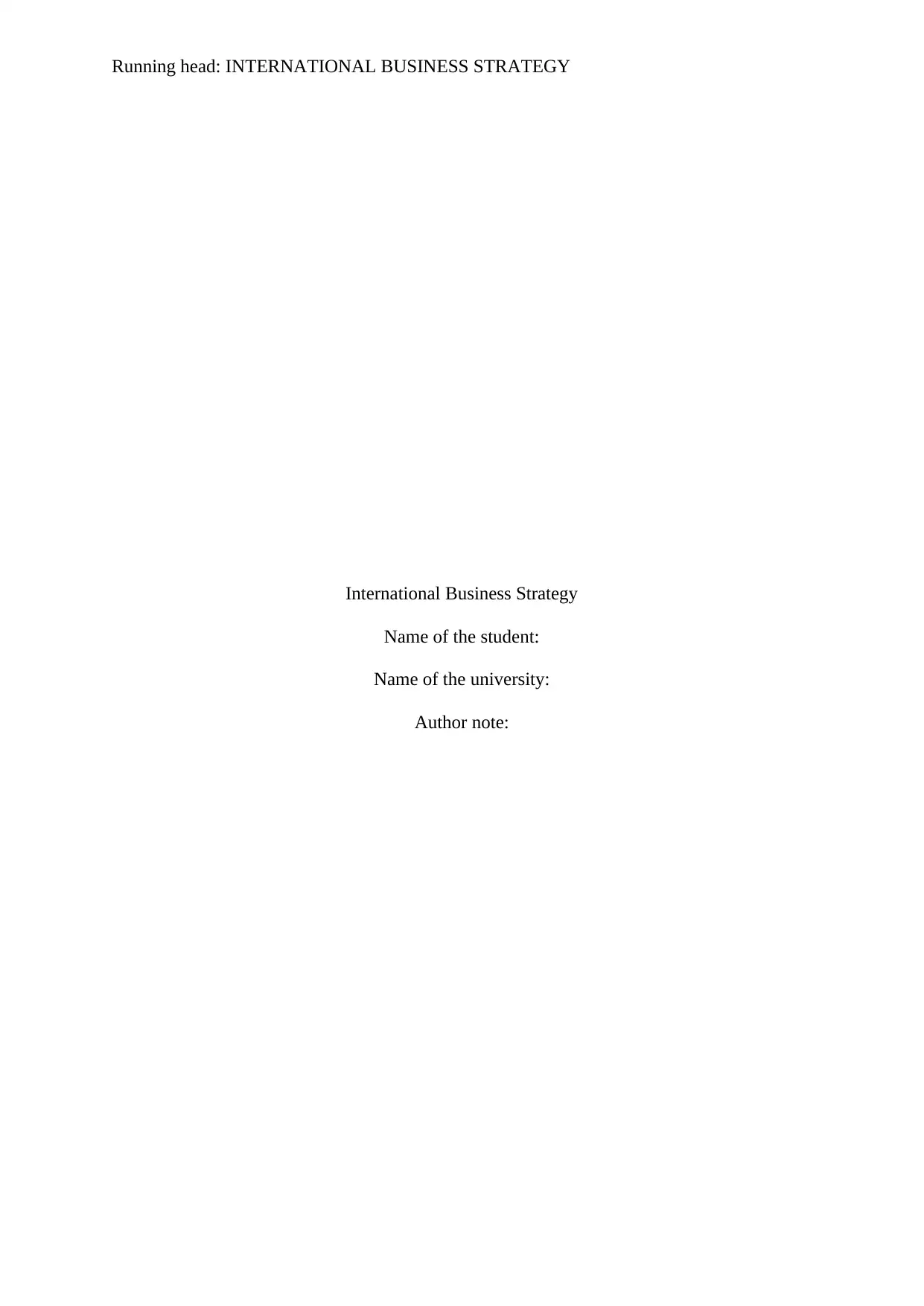
Running head: INTERNATIONAL BUSINESS STRATEGY
International Business Strategy
Name of the student:
Name of the university:
Author note:
International Business Strategy
Name of the student:
Name of the university:
Author note:
Secure Best Marks with AI Grader
Need help grading? Try our AI Grader for instant feedback on your assignments.
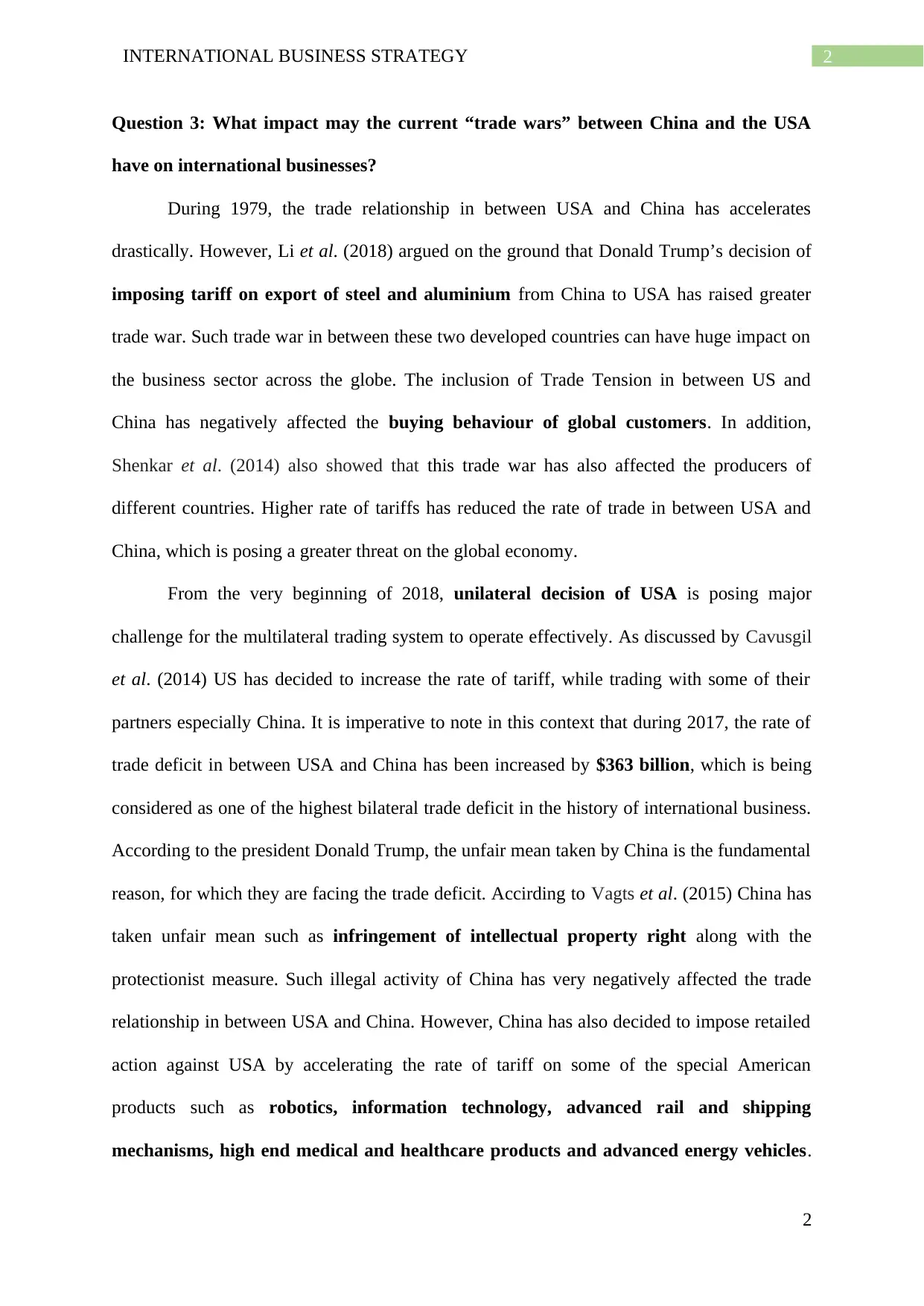
2INTERNATIONAL BUSINESS STRATEGY
Question 3: What impact may the current “trade wars” between China and the USA
have on international businesses?
During 1979, the trade relationship in between USA and China has accelerates
drastically. However, Li et al. (2018) argued on the ground that Donald Trump’s decision of
imposing tariff on export of steel and aluminium from China to USA has raised greater
trade war. Such trade war in between these two developed countries can have huge impact on
the business sector across the globe. The inclusion of Trade Tension in between US and
China has negatively affected the buying behaviour of global customers. In addition,
Shenkar et al. (2014) also showed that this trade war has also affected the producers of
different countries. Higher rate of tariffs has reduced the rate of trade in between USA and
China, which is posing a greater threat on the global economy.
From the very beginning of 2018, unilateral decision of USA is posing major
challenge for the multilateral trading system to operate effectively. As discussed by Cavusgil
et al. (2014) US has decided to increase the rate of tariff, while trading with some of their
partners especially China. It is imperative to note in this context that during 2017, the rate of
trade deficit in between USA and China has been increased by $363 billion, which is being
considered as one of the highest bilateral trade deficit in the history of international business.
According to the president Donald Trump, the unfair mean taken by China is the fundamental
reason, for which they are facing the trade deficit. Accirding to Vagts et al. (2015) China has
taken unfair mean such as infringement of intellectual property right along with the
protectionist measure. Such illegal activity of China has very negatively affected the trade
relationship in between USA and China. However, China has also decided to impose retailed
action against USA by accelerating the rate of tariff on some of the special American
products such as robotics, information technology, advanced rail and shipping
mechanisms, high end medical and healthcare products and advanced energy vehicles.
2
Question 3: What impact may the current “trade wars” between China and the USA
have on international businesses?
During 1979, the trade relationship in between USA and China has accelerates
drastically. However, Li et al. (2018) argued on the ground that Donald Trump’s decision of
imposing tariff on export of steel and aluminium from China to USA has raised greater
trade war. Such trade war in between these two developed countries can have huge impact on
the business sector across the globe. The inclusion of Trade Tension in between US and
China has negatively affected the buying behaviour of global customers. In addition,
Shenkar et al. (2014) also showed that this trade war has also affected the producers of
different countries. Higher rate of tariffs has reduced the rate of trade in between USA and
China, which is posing a greater threat on the global economy.
From the very beginning of 2018, unilateral decision of USA is posing major
challenge for the multilateral trading system to operate effectively. As discussed by Cavusgil
et al. (2014) US has decided to increase the rate of tariff, while trading with some of their
partners especially China. It is imperative to note in this context that during 2017, the rate of
trade deficit in between USA and China has been increased by $363 billion, which is being
considered as one of the highest bilateral trade deficit in the history of international business.
According to the president Donald Trump, the unfair mean taken by China is the fundamental
reason, for which they are facing the trade deficit. Accirding to Vagts et al. (2015) China has
taken unfair mean such as infringement of intellectual property right along with the
protectionist measure. Such illegal activity of China has very negatively affected the trade
relationship in between USA and China. However, China has also decided to impose retailed
action against USA by accelerating the rate of tariff on some of the special American
products such as robotics, information technology, advanced rail and shipping
mechanisms, high end medical and healthcare products and advanced energy vehicles.
2
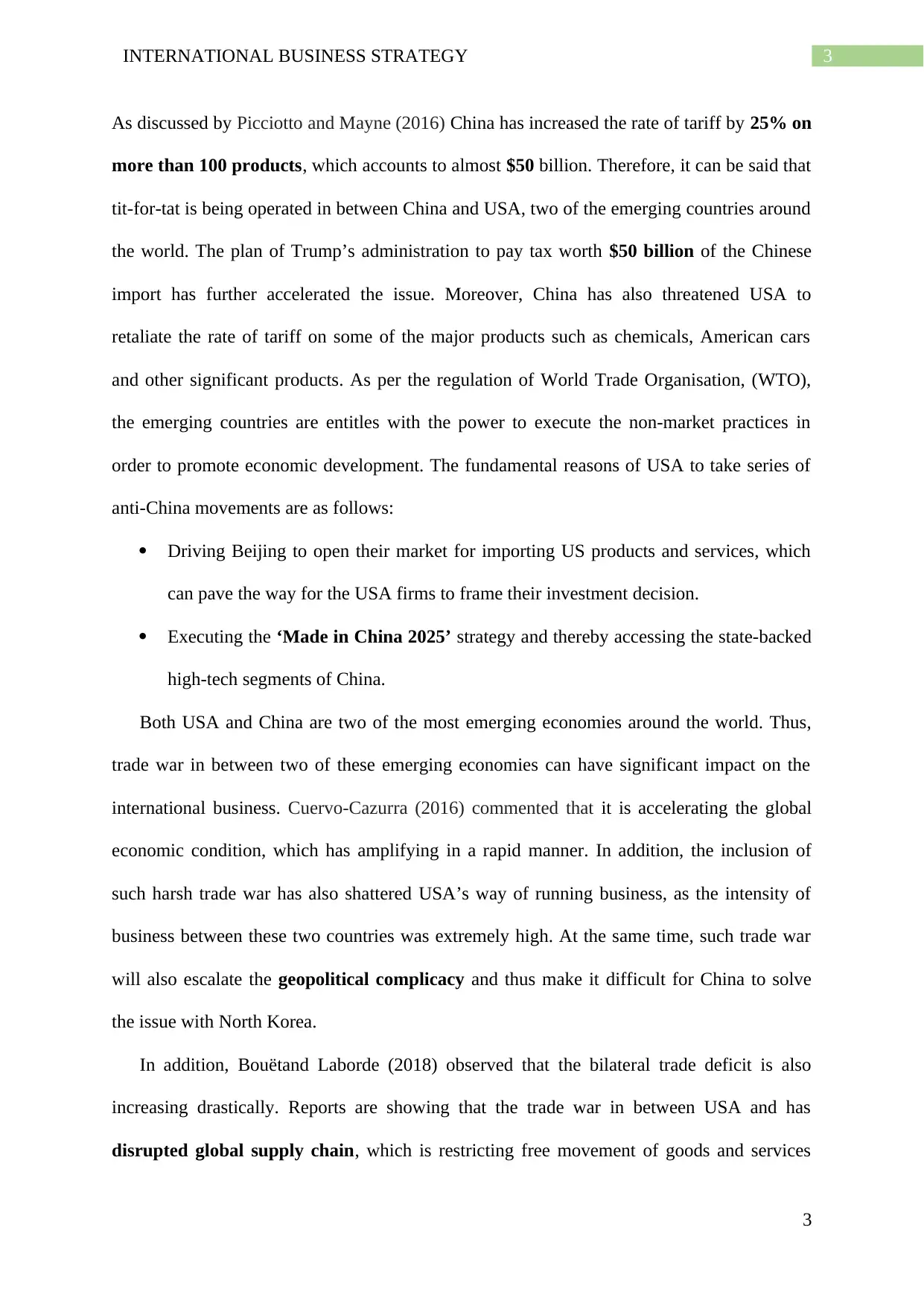
3INTERNATIONAL BUSINESS STRATEGY
As discussed by Picciotto and Mayne (2016) China has increased the rate of tariff by 25% on
more than 100 products, which accounts to almost $50 billion. Therefore, it can be said that
tit-for-tat is being operated in between China and USA, two of the emerging countries around
the world. The plan of Trump’s administration to pay tax worth $50 billion of the Chinese
import has further accelerated the issue. Moreover, China has also threatened USA to
retaliate the rate of tariff on some of the major products such as chemicals, American cars
and other significant products. As per the regulation of World Trade Organisation, (WTO),
the emerging countries are entitles with the power to execute the non-market practices in
order to promote economic development. The fundamental reasons of USA to take series of
anti-China movements are as follows:
Driving Beijing to open their market for importing US products and services, which
can pave the way for the USA firms to frame their investment decision.
Executing the ‘Made in China 2025’ strategy and thereby accessing the state-backed
high-tech segments of China.
Both USA and China are two of the most emerging economies around the world. Thus,
trade war in between two of these emerging economies can have significant impact on the
international business. Cuervo-Cazurra (2016) commented that it is accelerating the global
economic condition, which has amplifying in a rapid manner. In addition, the inclusion of
such harsh trade war has also shattered USA’s way of running business, as the intensity of
business between these two countries was extremely high. At the same time, such trade war
will also escalate the geopolitical complicacy and thus make it difficult for China to solve
the issue with North Korea.
In addition, Bouëtand Laborde (2018) observed that the bilateral trade deficit is also
increasing drastically. Reports are showing that the trade war in between USA and has
disrupted global supply chain, which is restricting free movement of goods and services
3
As discussed by Picciotto and Mayne (2016) China has increased the rate of tariff by 25% on
more than 100 products, which accounts to almost $50 billion. Therefore, it can be said that
tit-for-tat is being operated in between China and USA, two of the emerging countries around
the world. The plan of Trump’s administration to pay tax worth $50 billion of the Chinese
import has further accelerated the issue. Moreover, China has also threatened USA to
retaliate the rate of tariff on some of the major products such as chemicals, American cars
and other significant products. As per the regulation of World Trade Organisation, (WTO),
the emerging countries are entitles with the power to execute the non-market practices in
order to promote economic development. The fundamental reasons of USA to take series of
anti-China movements are as follows:
Driving Beijing to open their market for importing US products and services, which
can pave the way for the USA firms to frame their investment decision.
Executing the ‘Made in China 2025’ strategy and thereby accessing the state-backed
high-tech segments of China.
Both USA and China are two of the most emerging economies around the world. Thus,
trade war in between two of these emerging economies can have significant impact on the
international business. Cuervo-Cazurra (2016) commented that it is accelerating the global
economic condition, which has amplifying in a rapid manner. In addition, the inclusion of
such harsh trade war has also shattered USA’s way of running business, as the intensity of
business between these two countries was extremely high. At the same time, such trade war
will also escalate the geopolitical complicacy and thus make it difficult for China to solve
the issue with North Korea.
In addition, Bouëtand Laborde (2018) observed that the bilateral trade deficit is also
increasing drastically. Reports are showing that the trade war in between USA and has
disrupted global supply chain, which is restricting free movement of goods and services
3
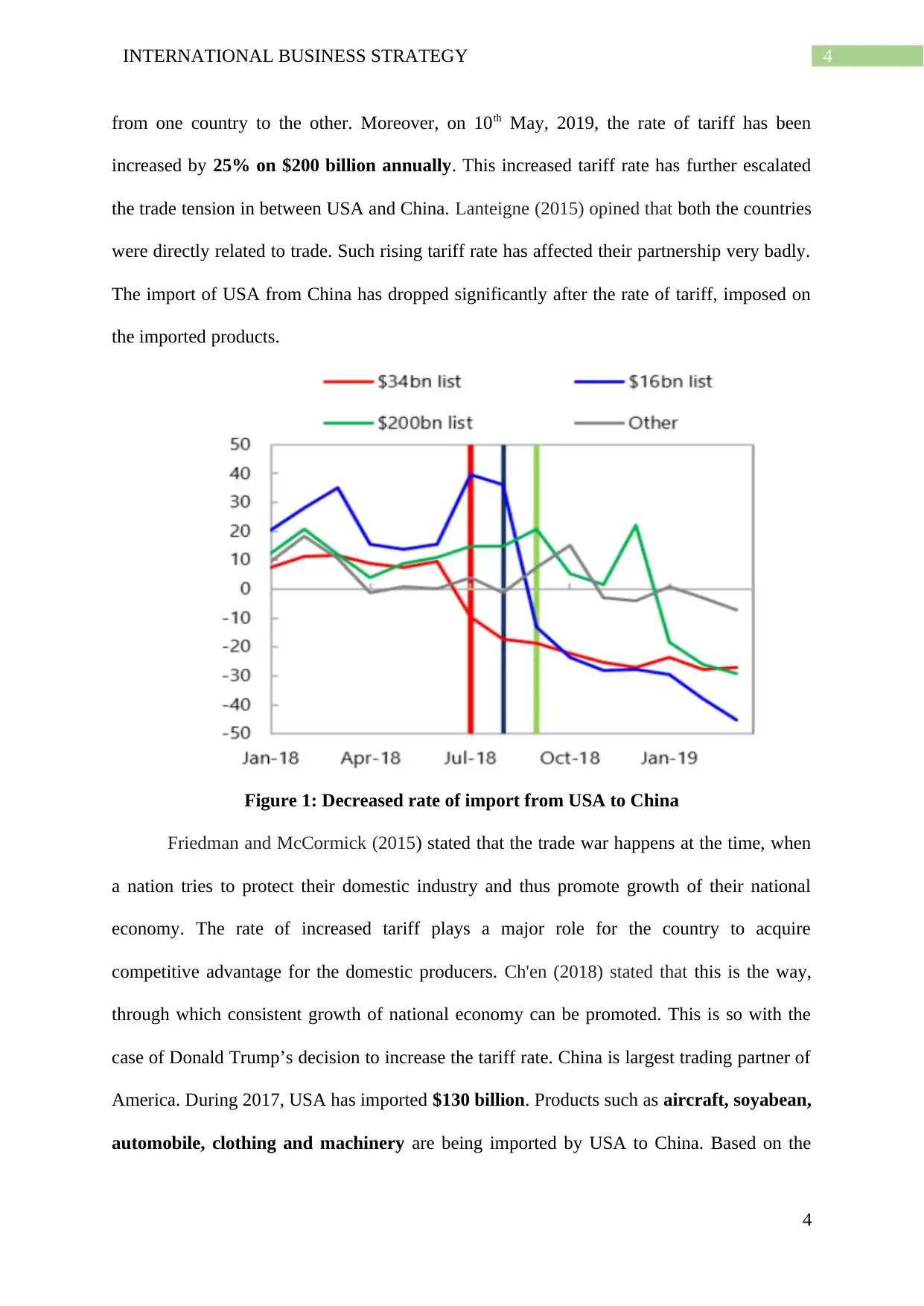
4INTERNATIONAL BUSINESS STRATEGY
from one country to the other. Moreover, on 10th May, 2019, the rate of tariff has been
increased by 25% on $200 billion annually. This increased tariff rate has further escalated
the trade tension in between USA and China. Lanteigne (2015) opined that both the countries
were directly related to trade. Such rising tariff rate has affected their partnership very badly.
The import of USA from China has dropped significantly after the rate of tariff, imposed on
the imported products.
Figure 1: Decreased rate of import from USA to China
Friedman and McCormick (2015) stated that the trade war happens at the time, when
a nation tries to protect their domestic industry and thus promote growth of their national
economy. The rate of increased tariff plays a major role for the country to acquire
competitive advantage for the domestic producers. Ch'en (2018) stated that this is the way,
through which consistent growth of national economy can be promoted. This is so with the
case of Donald Trump’s decision to increase the tariff rate. China is largest trading partner of
America. During 2017, USA has imported $130 billion. Products such as aircraft, soyabean,
automobile, clothing and machinery are being imported by USA to China. Based on the
4
from one country to the other. Moreover, on 10th May, 2019, the rate of tariff has been
increased by 25% on $200 billion annually. This increased tariff rate has further escalated
the trade tension in between USA and China. Lanteigne (2015) opined that both the countries
were directly related to trade. Such rising tariff rate has affected their partnership very badly.
The import of USA from China has dropped significantly after the rate of tariff, imposed on
the imported products.
Figure 1: Decreased rate of import from USA to China
Friedman and McCormick (2015) stated that the trade war happens at the time, when
a nation tries to protect their domestic industry and thus promote growth of their national
economy. The rate of increased tariff plays a major role for the country to acquire
competitive advantage for the domestic producers. Ch'en (2018) stated that this is the way,
through which consistent growth of national economy can be promoted. This is so with the
case of Donald Trump’s decision to increase the tariff rate. China is largest trading partner of
America. During 2017, USA has imported $130 billion. Products such as aircraft, soyabean,
automobile, clothing and machinery are being imported by USA to China. Based on the
4
Secure Best Marks with AI Grader
Need help grading? Try our AI Grader for instant feedback on your assignments.
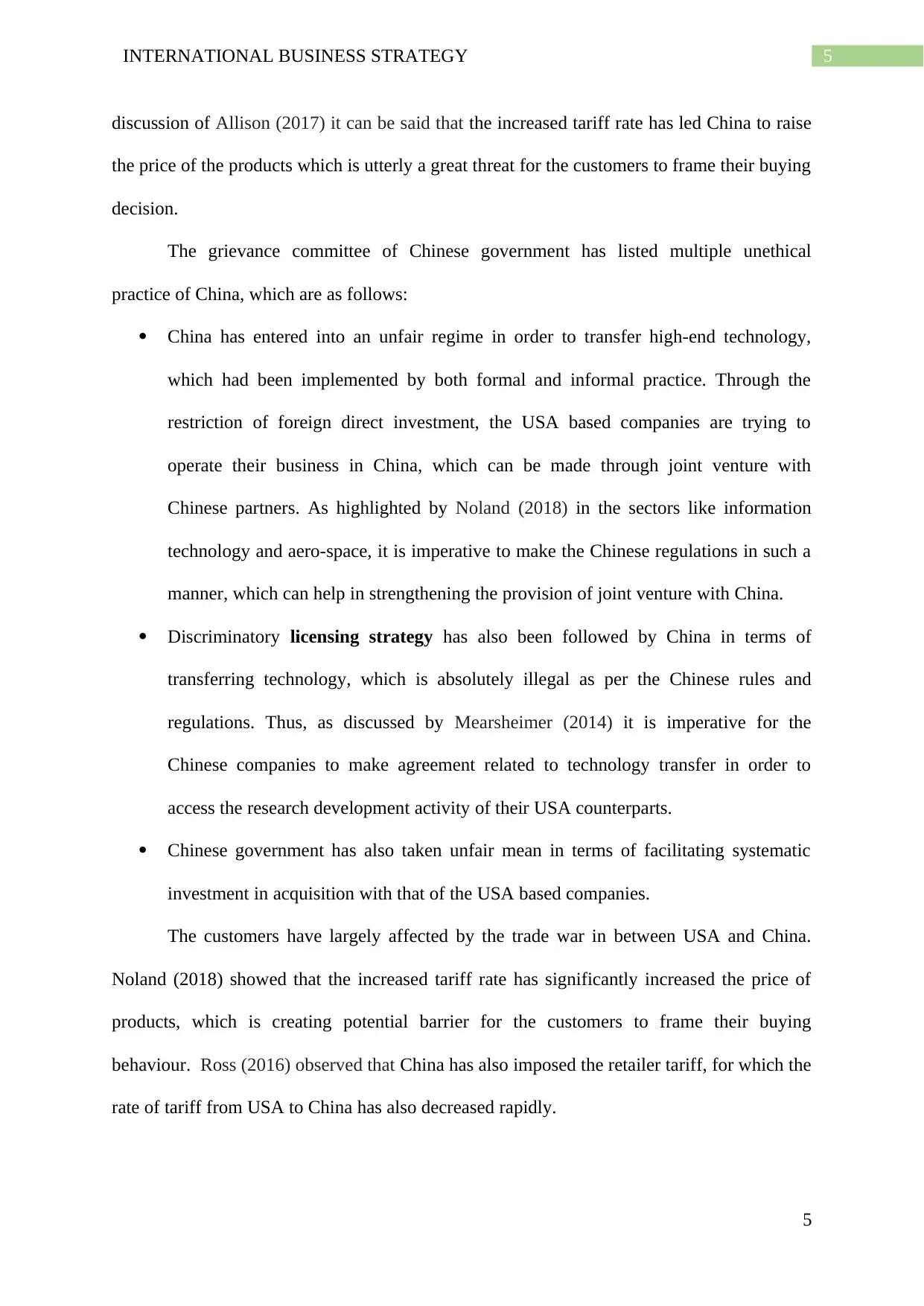
5INTERNATIONAL BUSINESS STRATEGY
discussion of Allison (2017) it can be said that the increased tariff rate has led China to raise
the price of the products which is utterly a great threat for the customers to frame their buying
decision.
The grievance committee of Chinese government has listed multiple unethical
practice of China, which are as follows:
China has entered into an unfair regime in order to transfer high-end technology,
which had been implemented by both formal and informal practice. Through the
restriction of foreign direct investment, the USA based companies are trying to
operate their business in China, which can be made through joint venture with
Chinese partners. As highlighted by Noland (2018) in the sectors like information
technology and aero-space, it is imperative to make the Chinese regulations in such a
manner, which can help in strengthening the provision of joint venture with China.
Discriminatory licensing strategy has also been followed by China in terms of
transferring technology, which is absolutely illegal as per the Chinese rules and
regulations. Thus, as discussed by Mearsheimer (2014) it is imperative for the
Chinese companies to make agreement related to technology transfer in order to
access the research development activity of their USA counterparts.
Chinese government has also taken unfair mean in terms of facilitating systematic
investment in acquisition with that of the USA based companies.
The customers have largely affected by the trade war in between USA and China.
Noland (2018) showed that the increased tariff rate has significantly increased the price of
products, which is creating potential barrier for the customers to frame their buying
behaviour. Ross (2016) observed that China has also imposed the retailer tariff, for which the
rate of tariff from USA to China has also decreased rapidly.
5
discussion of Allison (2017) it can be said that the increased tariff rate has led China to raise
the price of the products which is utterly a great threat for the customers to frame their buying
decision.
The grievance committee of Chinese government has listed multiple unethical
practice of China, which are as follows:
China has entered into an unfair regime in order to transfer high-end technology,
which had been implemented by both formal and informal practice. Through the
restriction of foreign direct investment, the USA based companies are trying to
operate their business in China, which can be made through joint venture with
Chinese partners. As highlighted by Noland (2018) in the sectors like information
technology and aero-space, it is imperative to make the Chinese regulations in such a
manner, which can help in strengthening the provision of joint venture with China.
Discriminatory licensing strategy has also been followed by China in terms of
transferring technology, which is absolutely illegal as per the Chinese rules and
regulations. Thus, as discussed by Mearsheimer (2014) it is imperative for the
Chinese companies to make agreement related to technology transfer in order to
access the research development activity of their USA counterparts.
Chinese government has also taken unfair mean in terms of facilitating systematic
investment in acquisition with that of the USA based companies.
The customers have largely affected by the trade war in between USA and China.
Noland (2018) showed that the increased tariff rate has significantly increased the price of
products, which is creating potential barrier for the customers to frame their buying
behaviour. Ross (2016) observed that China has also imposed the retailer tariff, for which the
rate of tariff from USA to China has also decreased rapidly.
5
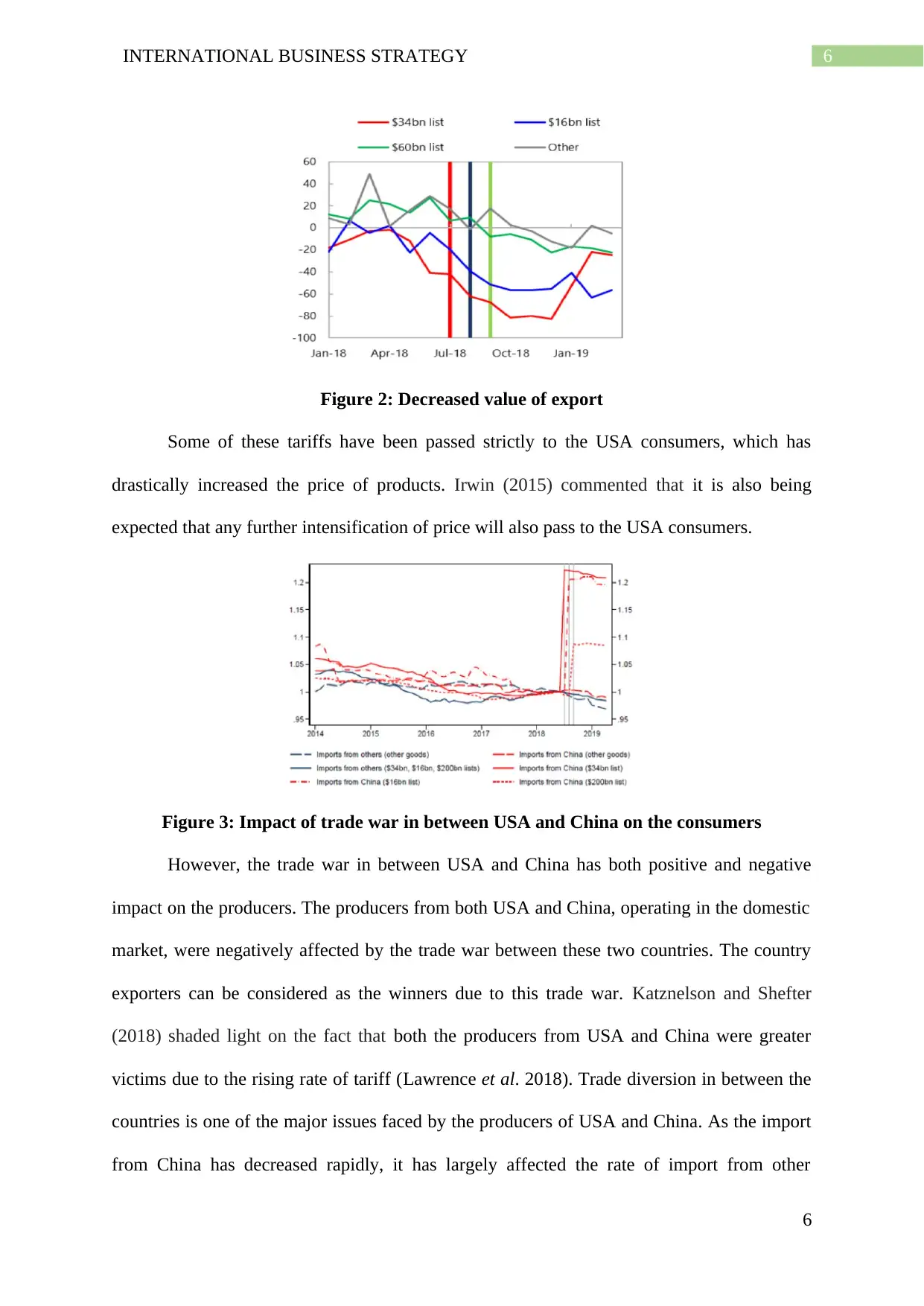
6INTERNATIONAL BUSINESS STRATEGY
Figure 2: Decreased value of export
Some of these tariffs have been passed strictly to the USA consumers, which has
drastically increased the price of products. Irwin (2015) commented that it is also being
expected that any further intensification of price will also pass to the USA consumers.
Figure 3: Impact of trade war in between USA and China on the consumers
However, the trade war in between USA and China has both positive and negative
impact on the producers. The producers from both USA and China, operating in the domestic
market, were negatively affected by the trade war between these two countries. The country
exporters can be considered as the winners due to this trade war. Katznelson and Shefter
(2018) shaded light on the fact that both the producers from USA and China were greater
victims due to the rising rate of tariff (Lawrence et al. 2018). Trade diversion in between the
countries is one of the major issues faced by the producers of USA and China. As the import
from China has decreased rapidly, it has largely affected the rate of import from other
6
Figure 2: Decreased value of export
Some of these tariffs have been passed strictly to the USA consumers, which has
drastically increased the price of products. Irwin (2015) commented that it is also being
expected that any further intensification of price will also pass to the USA consumers.
Figure 3: Impact of trade war in between USA and China on the consumers
However, the trade war in between USA and China has both positive and negative
impact on the producers. The producers from both USA and China, operating in the domestic
market, were negatively affected by the trade war between these two countries. The country
exporters can be considered as the winners due to this trade war. Katznelson and Shefter
(2018) shaded light on the fact that both the producers from USA and China were greater
victims due to the rising rate of tariff (Lawrence et al. 2018). Trade diversion in between the
countries is one of the major issues faced by the producers of USA and China. As the import
from China has decreased rapidly, it has largely affected the rate of import from other
6
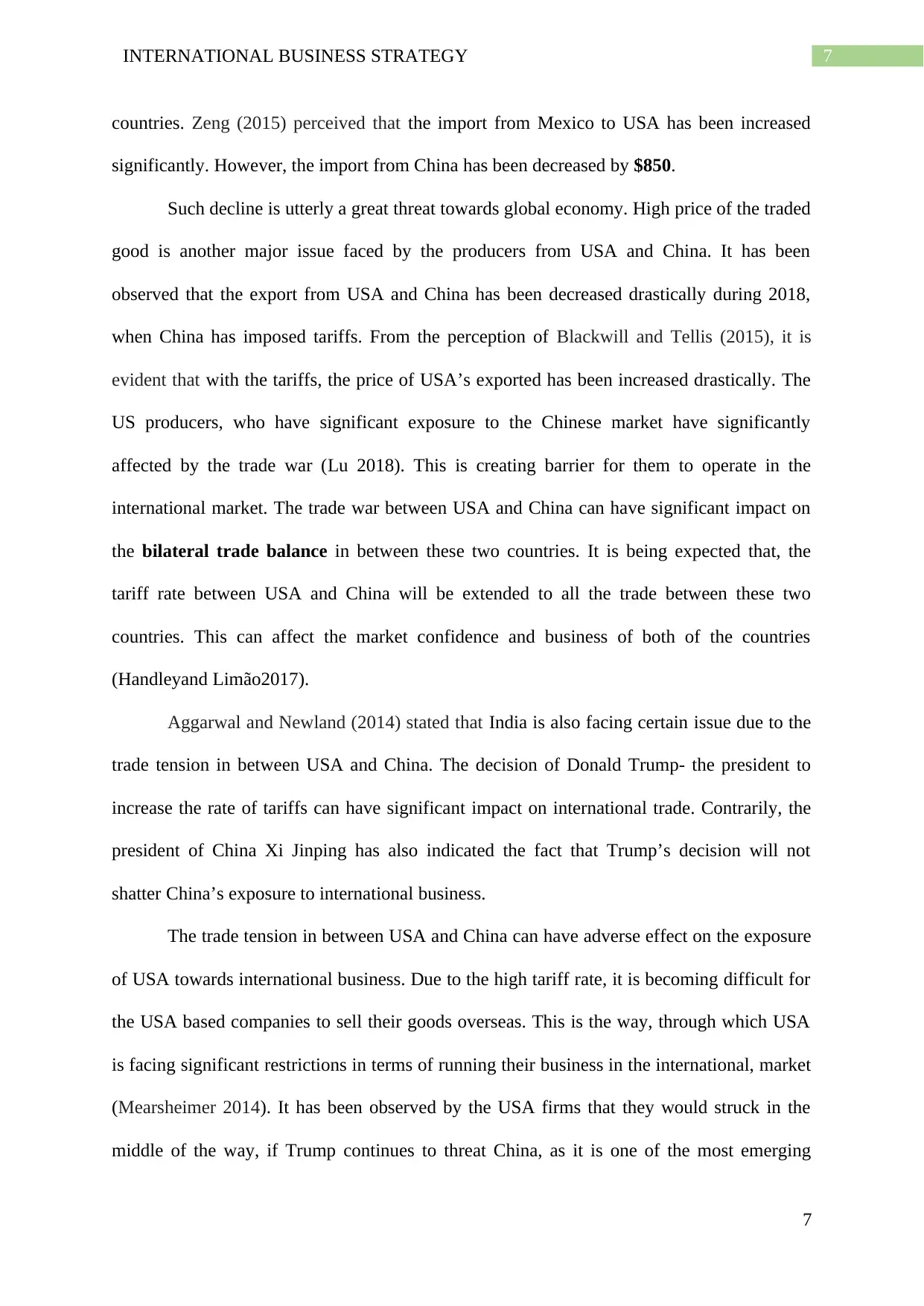
7INTERNATIONAL BUSINESS STRATEGY
countries. Zeng (2015) perceived that the import from Mexico to USA has been increased
significantly. However, the import from China has been decreased by $850.
Such decline is utterly a great threat towards global economy. High price of the traded
good is another major issue faced by the producers from USA and China. It has been
observed that the export from USA and China has been decreased drastically during 2018,
when China has imposed tariffs. From the perception of Blackwill and Tellis (2015), it is
evident that with the tariffs, the price of USA’s exported has been increased drastically. The
US producers, who have significant exposure to the Chinese market have significantly
affected by the trade war (Lu 2018). This is creating barrier for them to operate in the
international market. The trade war between USA and China can have significant impact on
the bilateral trade balance in between these two countries. It is being expected that, the
tariff rate between USA and China will be extended to all the trade between these two
countries. This can affect the market confidence and business of both of the countries
(Handleyand Limão2017).
Aggarwal and Newland (2014) stated that India is also facing certain issue due to the
trade tension in between USA and China. The decision of Donald Trump- the president to
increase the rate of tariffs can have significant impact on international trade. Contrarily, the
president of China Xi Jinping has also indicated the fact that Trump’s decision will not
shatter China’s exposure to international business.
The trade tension in between USA and China can have adverse effect on the exposure
of USA towards international business. Due to the high tariff rate, it is becoming difficult for
the USA based companies to sell their goods overseas. This is the way, through which USA
is facing significant restrictions in terms of running their business in the international, market
(Mearsheimer 2014). It has been observed by the USA firms that they would struck in the
middle of the way, if Trump continues to threat China, as it is one of the most emerging
7
countries. Zeng (2015) perceived that the import from Mexico to USA has been increased
significantly. However, the import from China has been decreased by $850.
Such decline is utterly a great threat towards global economy. High price of the traded
good is another major issue faced by the producers from USA and China. It has been
observed that the export from USA and China has been decreased drastically during 2018,
when China has imposed tariffs. From the perception of Blackwill and Tellis (2015), it is
evident that with the tariffs, the price of USA’s exported has been increased drastically. The
US producers, who have significant exposure to the Chinese market have significantly
affected by the trade war (Lu 2018). This is creating barrier for them to operate in the
international market. The trade war between USA and China can have significant impact on
the bilateral trade balance in between these two countries. It is being expected that, the
tariff rate between USA and China will be extended to all the trade between these two
countries. This can affect the market confidence and business of both of the countries
(Handleyand Limão2017).
Aggarwal and Newland (2014) stated that India is also facing certain issue due to the
trade tension in between USA and China. The decision of Donald Trump- the president to
increase the rate of tariffs can have significant impact on international trade. Contrarily, the
president of China Xi Jinping has also indicated the fact that Trump’s decision will not
shatter China’s exposure to international business.
The trade tension in between USA and China can have adverse effect on the exposure
of USA towards international business. Due to the high tariff rate, it is becoming difficult for
the USA based companies to sell their goods overseas. This is the way, through which USA
is facing significant restrictions in terms of running their business in the international, market
(Mearsheimer 2014). It has been observed by the USA firms that they would struck in the
middle of the way, if Trump continues to threat China, as it is one of the most emerging
7
Paraphrase This Document
Need a fresh take? Get an instant paraphrase of this document with our AI Paraphraser
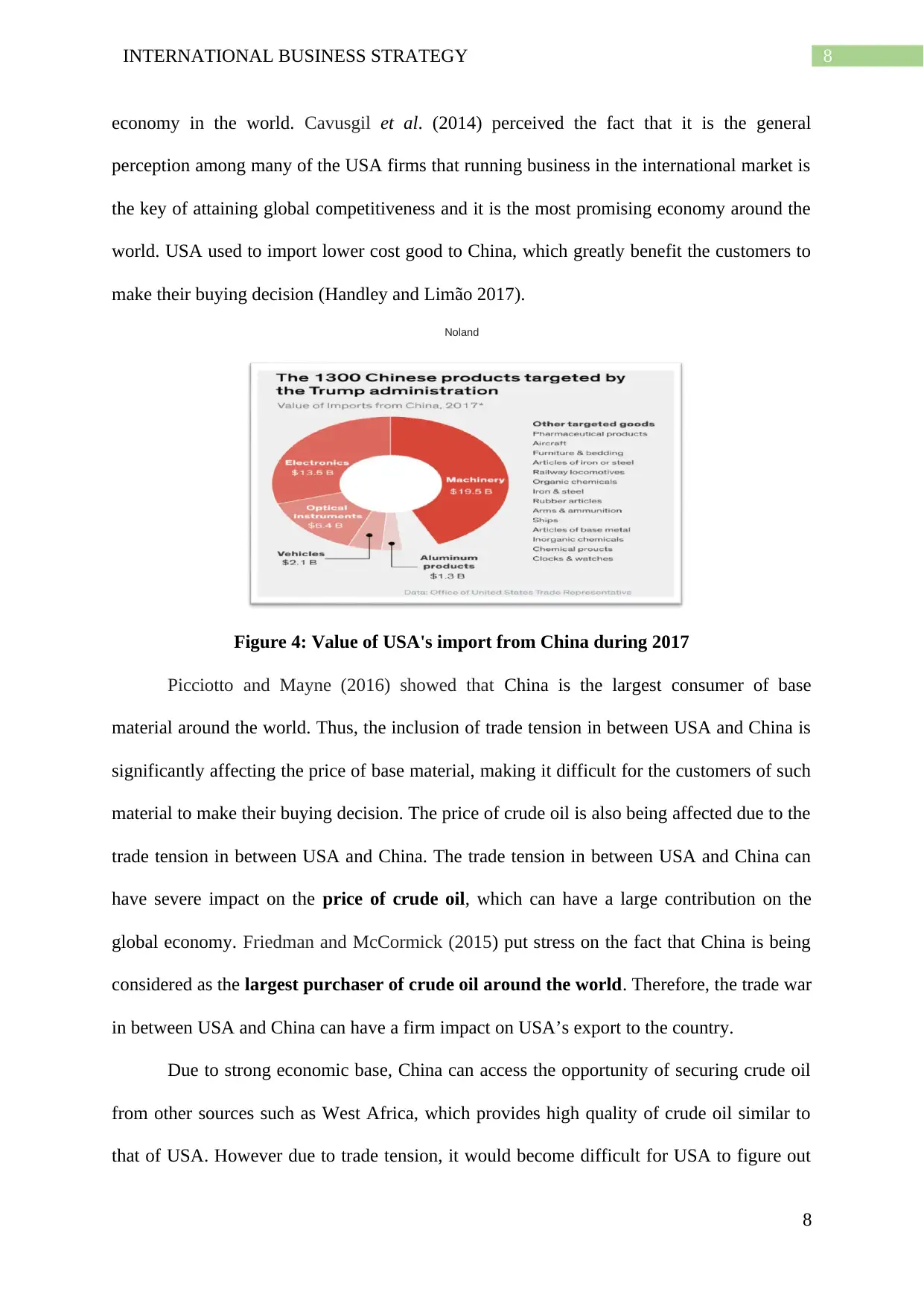
8INTERNATIONAL BUSINESS STRATEGY
economy in the world. Cavusgil et al. (2014) perceived the fact that it is the general
perception among many of the USA firms that running business in the international market is
the key of attaining global competitiveness and it is the most promising economy around the
world. USA used to import lower cost good to China, which greatly benefit the customers to
make their buying decision (Handley and Limão 2017).
Noland
Figure 4: Value of USA's import from China during 2017
Picciotto and Mayne (2016) showed that China is the largest consumer of base
material around the world. Thus, the inclusion of trade tension in between USA and China is
significantly affecting the price of base material, making it difficult for the customers of such
material to make their buying decision. The price of crude oil is also being affected due to the
trade tension in between USA and China. The trade tension in between USA and China can
have severe impact on the price of crude oil, which can have a large contribution on the
global economy. Friedman and McCormick (2015) put stress on the fact that China is being
considered as the largest purchaser of crude oil around the world. Therefore, the trade war
in between USA and China can have a firm impact on USA’s export to the country.
Due to strong economic base, China can access the opportunity of securing crude oil
from other sources such as West Africa, which provides high quality of crude oil similar to
that of USA. However due to trade tension, it would become difficult for USA to figure out
8
economy in the world. Cavusgil et al. (2014) perceived the fact that it is the general
perception among many of the USA firms that running business in the international market is
the key of attaining global competitiveness and it is the most promising economy around the
world. USA used to import lower cost good to China, which greatly benefit the customers to
make their buying decision (Handley and Limão 2017).
Noland
Figure 4: Value of USA's import from China during 2017
Picciotto and Mayne (2016) showed that China is the largest consumer of base
material around the world. Thus, the inclusion of trade tension in between USA and China is
significantly affecting the price of base material, making it difficult for the customers of such
material to make their buying decision. The price of crude oil is also being affected due to the
trade tension in between USA and China. The trade tension in between USA and China can
have severe impact on the price of crude oil, which can have a large contribution on the
global economy. Friedman and McCormick (2015) put stress on the fact that China is being
considered as the largest purchaser of crude oil around the world. Therefore, the trade war
in between USA and China can have a firm impact on USA’s export to the country.
Due to strong economic base, China can access the opportunity of securing crude oil
from other sources such as West Africa, which provides high quality of crude oil similar to
that of USA. However due to trade tension, it would become difficult for USA to figure out
8
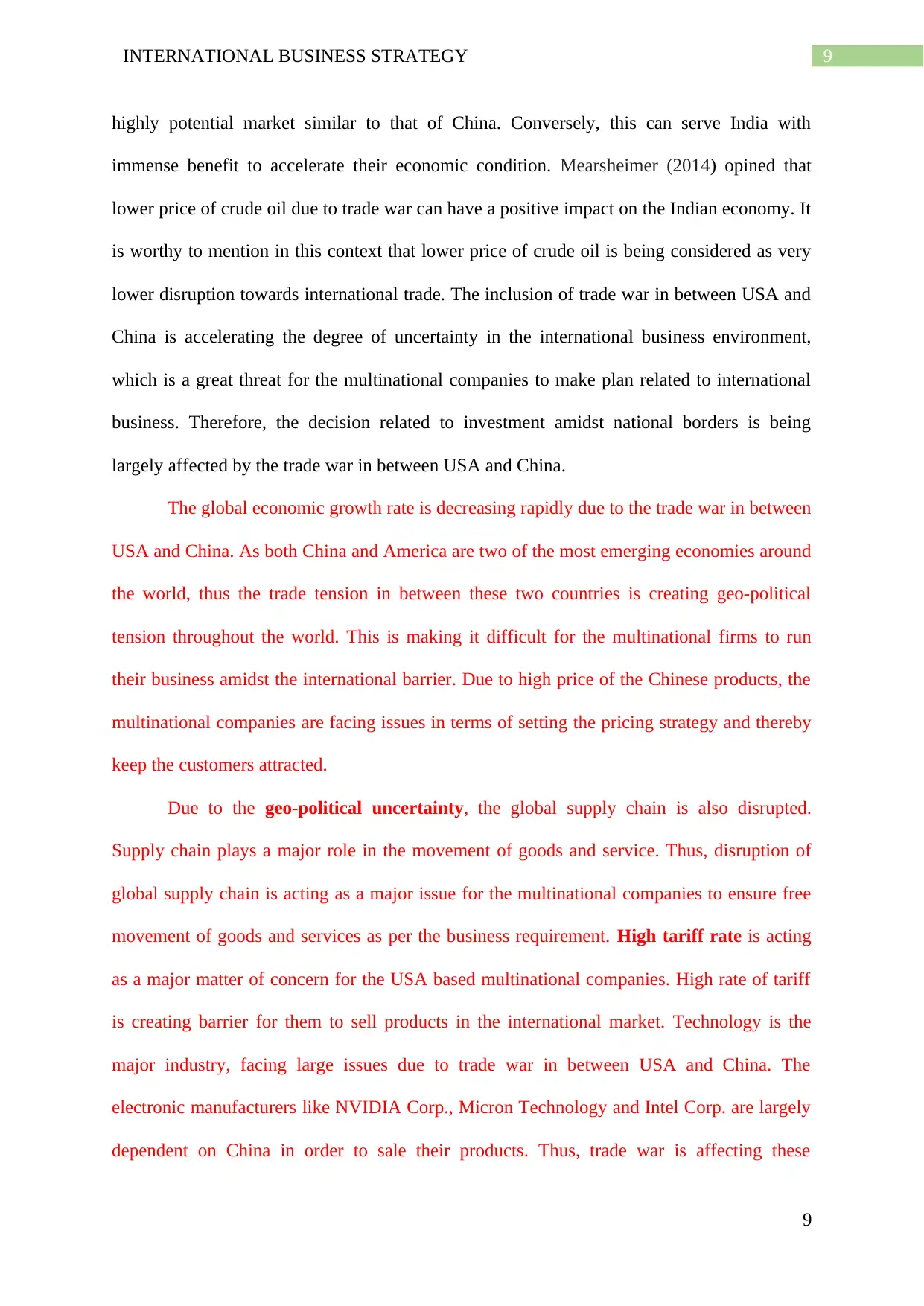
9INTERNATIONAL BUSINESS STRATEGY
highly potential market similar to that of China. Conversely, this can serve India with
immense benefit to accelerate their economic condition. Mearsheimer (2014) opined that
lower price of crude oil due to trade war can have a positive impact on the Indian economy. It
is worthy to mention in this context that lower price of crude oil is being considered as very
lower disruption towards international trade. The inclusion of trade war in between USA and
China is accelerating the degree of uncertainty in the international business environment,
which is a great threat for the multinational companies to make plan related to international
business. Therefore, the decision related to investment amidst national borders is being
largely affected by the trade war in between USA and China.
The global economic growth rate is decreasing rapidly due to the trade war in between
USA and China. As both China and America are two of the most emerging economies around
the world, thus the trade tension in between these two countries is creating geo-political
tension throughout the world. This is making it difficult for the multinational firms to run
their business amidst the international barrier. Due to high price of the Chinese products, the
multinational companies are facing issues in terms of setting the pricing strategy and thereby
keep the customers attracted.
Due to the geo-political uncertainty, the global supply chain is also disrupted.
Supply chain plays a major role in the movement of goods and service. Thus, disruption of
global supply chain is acting as a major issue for the multinational companies to ensure free
movement of goods and services as per the business requirement. High tariff rate is acting
as a major matter of concern for the USA based multinational companies. High rate of tariff
is creating barrier for them to sell products in the international market. Technology is the
major industry, facing large issues due to trade war in between USA and China. The
electronic manufacturers like NVIDIA Corp., Micron Technology and Intel Corp. are largely
dependent on China in order to sale their products. Thus, trade war is affecting these
9
highly potential market similar to that of China. Conversely, this can serve India with
immense benefit to accelerate their economic condition. Mearsheimer (2014) opined that
lower price of crude oil due to trade war can have a positive impact on the Indian economy. It
is worthy to mention in this context that lower price of crude oil is being considered as very
lower disruption towards international trade. The inclusion of trade war in between USA and
China is accelerating the degree of uncertainty in the international business environment,
which is a great threat for the multinational companies to make plan related to international
business. Therefore, the decision related to investment amidst national borders is being
largely affected by the trade war in between USA and China.
The global economic growth rate is decreasing rapidly due to the trade war in between
USA and China. As both China and America are two of the most emerging economies around
the world, thus the trade tension in between these two countries is creating geo-political
tension throughout the world. This is making it difficult for the multinational firms to run
their business amidst the international barrier. Due to high price of the Chinese products, the
multinational companies are facing issues in terms of setting the pricing strategy and thereby
keep the customers attracted.
Due to the geo-political uncertainty, the global supply chain is also disrupted.
Supply chain plays a major role in the movement of goods and service. Thus, disruption of
global supply chain is acting as a major issue for the multinational companies to ensure free
movement of goods and services as per the business requirement. High tariff rate is acting
as a major matter of concern for the USA based multinational companies. High rate of tariff
is creating barrier for them to sell products in the international market. Technology is the
major industry, facing large issues due to trade war in between USA and China. The
electronic manufacturers like NVIDIA Corp., Micron Technology and Intel Corp. are largely
dependent on China in order to sale their products. Thus, trade war is affecting these
9
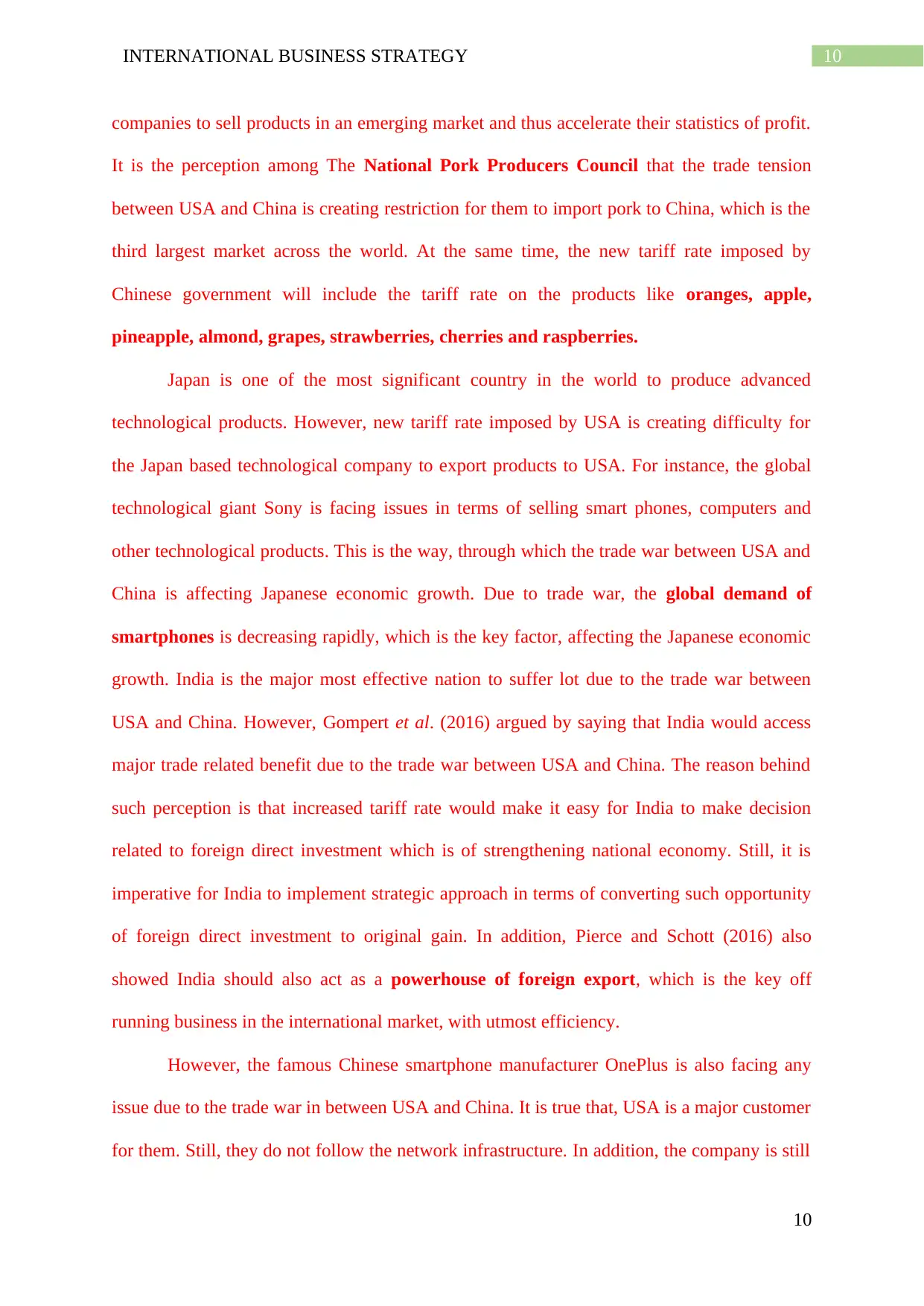
10INTERNATIONAL BUSINESS STRATEGY
companies to sell products in an emerging market and thus accelerate their statistics of profit.
It is the perception among The National Pork Producers Council that the trade tension
between USA and China is creating restriction for them to import pork to China, which is the
third largest market across the world. At the same time, the new tariff rate imposed by
Chinese government will include the tariff rate on the products like oranges, apple,
pineapple, almond, grapes, strawberries, cherries and raspberries.
Japan is one of the most significant country in the world to produce advanced
technological products. However, new tariff rate imposed by USA is creating difficulty for
the Japan based technological company to export products to USA. For instance, the global
technological giant Sony is facing issues in terms of selling smart phones, computers and
other technological products. This is the way, through which the trade war between USA and
China is affecting Japanese economic growth. Due to trade war, the global demand of
smartphones is decreasing rapidly, which is the key factor, affecting the Japanese economic
growth. India is the major most effective nation to suffer lot due to the trade war between
USA and China. However, Gompert et al. (2016) argued by saying that India would access
major trade related benefit due to the trade war between USA and China. The reason behind
such perception is that increased tariff rate would make it easy for India to make decision
related to foreign direct investment which is of strengthening national economy. Still, it is
imperative for India to implement strategic approach in terms of converting such opportunity
of foreign direct investment to original gain. In addition, Pierce and Schott (2016) also
showed India should also act as a powerhouse of foreign export, which is the key off
running business in the international market, with utmost efficiency.
However, the famous Chinese smartphone manufacturer OnePlus is also facing any
issue due to the trade war in between USA and China. It is true that, USA is a major customer
for them. Still, they do not follow the network infrastructure. In addition, the company is still
10
companies to sell products in an emerging market and thus accelerate their statistics of profit.
It is the perception among The National Pork Producers Council that the trade tension
between USA and China is creating restriction for them to import pork to China, which is the
third largest market across the world. At the same time, the new tariff rate imposed by
Chinese government will include the tariff rate on the products like oranges, apple,
pineapple, almond, grapes, strawberries, cherries and raspberries.
Japan is one of the most significant country in the world to produce advanced
technological products. However, new tariff rate imposed by USA is creating difficulty for
the Japan based technological company to export products to USA. For instance, the global
technological giant Sony is facing issues in terms of selling smart phones, computers and
other technological products. This is the way, through which the trade war between USA and
China is affecting Japanese economic growth. Due to trade war, the global demand of
smartphones is decreasing rapidly, which is the key factor, affecting the Japanese economic
growth. India is the major most effective nation to suffer lot due to the trade war between
USA and China. However, Gompert et al. (2016) argued by saying that India would access
major trade related benefit due to the trade war between USA and China. The reason behind
such perception is that increased tariff rate would make it easy for India to make decision
related to foreign direct investment which is of strengthening national economy. Still, it is
imperative for India to implement strategic approach in terms of converting such opportunity
of foreign direct investment to original gain. In addition, Pierce and Schott (2016) also
showed India should also act as a powerhouse of foreign export, which is the key off
running business in the international market, with utmost efficiency.
However, the famous Chinese smartphone manufacturer OnePlus is also facing any
issue due to the trade war in between USA and China. It is true that, USA is a major customer
for them. Still, they do not follow the network infrastructure. In addition, the company is still
10
Secure Best Marks with AI Grader
Need help grading? Try our AI Grader for instant feedback on your assignments.
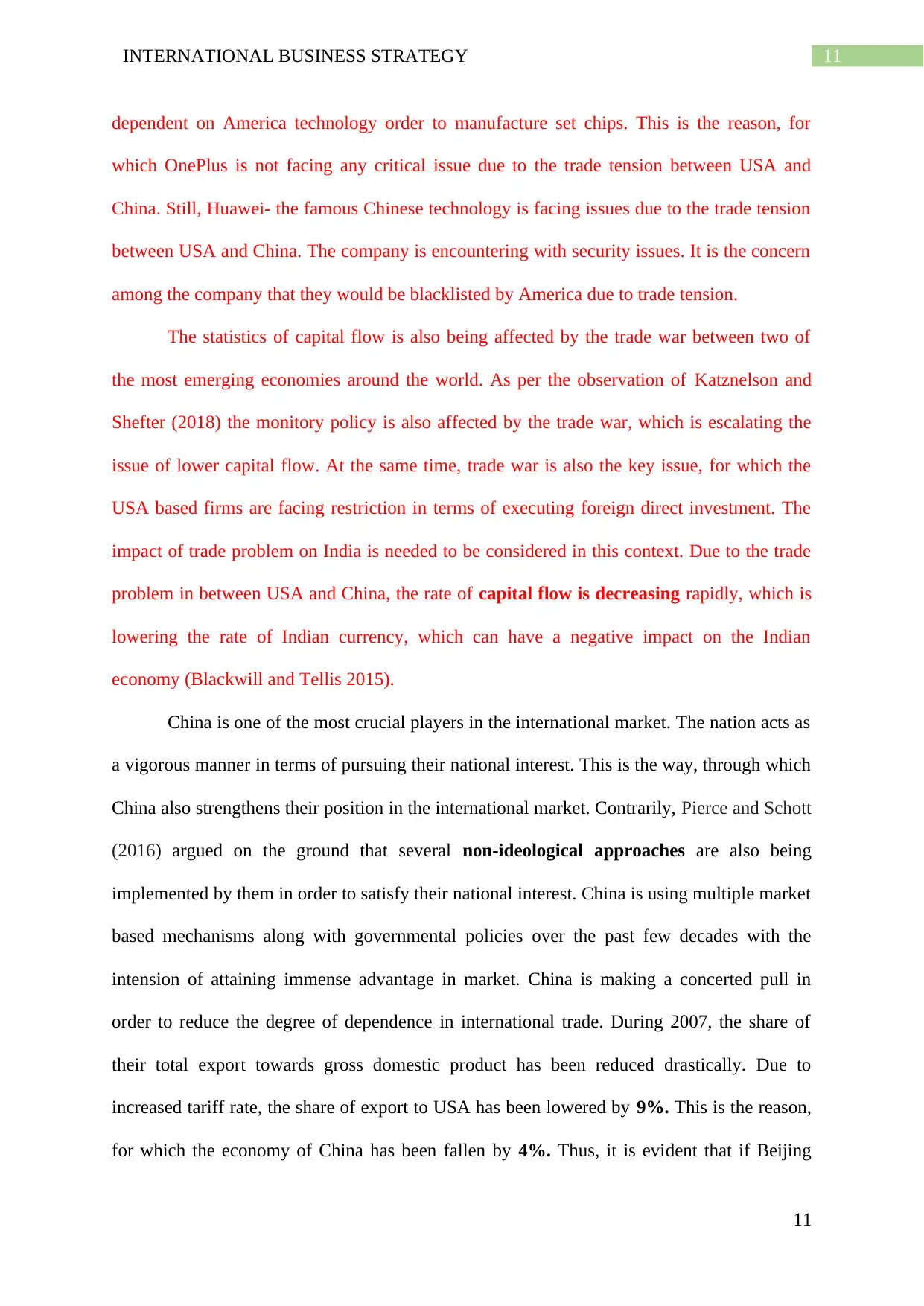
11INTERNATIONAL BUSINESS STRATEGY
dependent on America technology order to manufacture set chips. This is the reason, for
which OnePlus is not facing any critical issue due to the trade tension between USA and
China. Still, Huawei- the famous Chinese technology is facing issues due to the trade tension
between USA and China. The company is encountering with security issues. It is the concern
among the company that they would be blacklisted by America due to trade tension.
The statistics of capital flow is also being affected by the trade war between two of
the most emerging economies around the world. As per the observation of Katznelson and
Shefter (2018) the monitory policy is also affected by the trade war, which is escalating the
issue of lower capital flow. At the same time, trade war is also the key issue, for which the
USA based firms are facing restriction in terms of executing foreign direct investment. The
impact of trade problem on India is needed to be considered in this context. Due to the trade
problem in between USA and China, the rate of capital flow is decreasing rapidly, which is
lowering the rate of Indian currency, which can have a negative impact on the Indian
economy (Blackwill and Tellis 2015).
China is one of the most crucial players in the international market. The nation acts as
a vigorous manner in terms of pursuing their national interest. This is the way, through which
China also strengthens their position in the international market. Contrarily, Pierce and Schott
(2016) argued on the ground that several non-ideological approaches are also being
implemented by them in order to satisfy their national interest. China is using multiple market
based mechanisms along with governmental policies over the past few decades with the
intension of attaining immense advantage in market. China is making a concerted pull in
order to reduce the degree of dependence in international trade. During 2007, the share of
their total export towards gross domestic product has been reduced drastically. Due to
increased tariff rate, the share of export to USA has been lowered by 9%. This is the reason,
for which the economy of China has been fallen by 4%. Thus, it is evident that if Beijing
11
dependent on America technology order to manufacture set chips. This is the reason, for
which OnePlus is not facing any critical issue due to the trade tension between USA and
China. Still, Huawei- the famous Chinese technology is facing issues due to the trade tension
between USA and China. The company is encountering with security issues. It is the concern
among the company that they would be blacklisted by America due to trade tension.
The statistics of capital flow is also being affected by the trade war between two of
the most emerging economies around the world. As per the observation of Katznelson and
Shefter (2018) the monitory policy is also affected by the trade war, which is escalating the
issue of lower capital flow. At the same time, trade war is also the key issue, for which the
USA based firms are facing restriction in terms of executing foreign direct investment. The
impact of trade problem on India is needed to be considered in this context. Due to the trade
problem in between USA and China, the rate of capital flow is decreasing rapidly, which is
lowering the rate of Indian currency, which can have a negative impact on the Indian
economy (Blackwill and Tellis 2015).
China is one of the most crucial players in the international market. The nation acts as
a vigorous manner in terms of pursuing their national interest. This is the way, through which
China also strengthens their position in the international market. Contrarily, Pierce and Schott
(2016) argued on the ground that several non-ideological approaches are also being
implemented by them in order to satisfy their national interest. China is using multiple market
based mechanisms along with governmental policies over the past few decades with the
intension of attaining immense advantage in market. China is making a concerted pull in
order to reduce the degree of dependence in international trade. During 2007, the share of
their total export towards gross domestic product has been reduced drastically. Due to
increased tariff rate, the share of export to USA has been lowered by 9%. This is the reason,
for which the economy of China has been fallen by 4%. Thus, it is evident that if Beijing
11
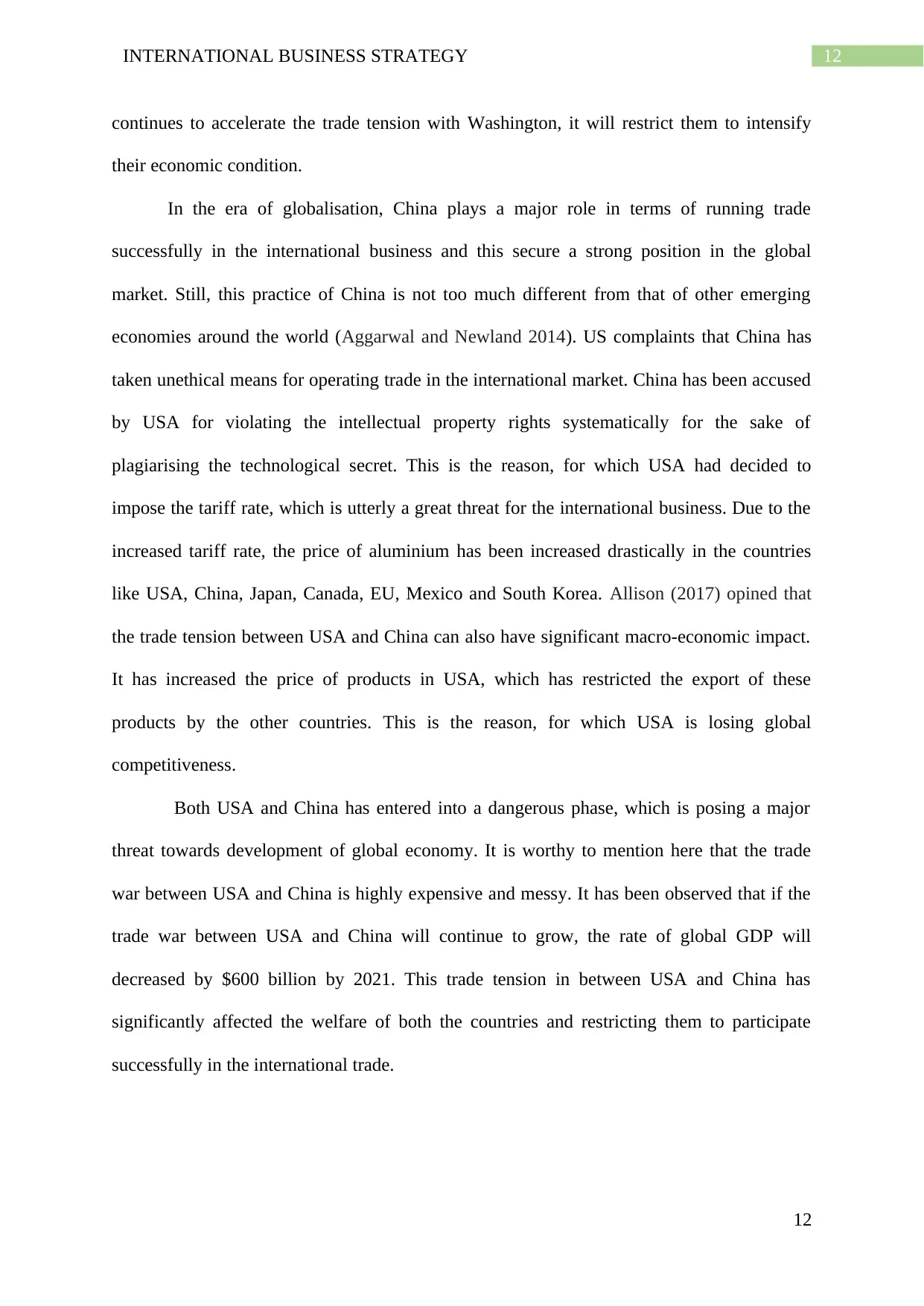
12INTERNATIONAL BUSINESS STRATEGY
continues to accelerate the trade tension with Washington, it will restrict them to intensify
their economic condition.
In the era of globalisation, China plays a major role in terms of running trade
successfully in the international business and this secure a strong position in the global
market. Still, this practice of China is not too much different from that of other emerging
economies around the world (Aggarwal and Newland 2014). US complaints that China has
taken unethical means for operating trade in the international market. China has been accused
by USA for violating the intellectual property rights systematically for the sake of
plagiarising the technological secret. This is the reason, for which USA had decided to
impose the tariff rate, which is utterly a great threat for the international business. Due to the
increased tariff rate, the price of aluminium has been increased drastically in the countries
like USA, China, Japan, Canada, EU, Mexico and South Korea. Allison (2017) opined that
the trade tension between USA and China can also have significant macro-economic impact.
It has increased the price of products in USA, which has restricted the export of these
products by the other countries. This is the reason, for which USA is losing global
competitiveness.
Both USA and China has entered into a dangerous phase, which is posing a major
threat towards development of global economy. It is worthy to mention here that the trade
war between USA and China is highly expensive and messy. It has been observed that if the
trade war between USA and China will continue to grow, the rate of global GDP will
decreased by $600 billion by 2021. This trade tension in between USA and China has
significantly affected the welfare of both the countries and restricting them to participate
successfully in the international trade.
12
continues to accelerate the trade tension with Washington, it will restrict them to intensify
their economic condition.
In the era of globalisation, China plays a major role in terms of running trade
successfully in the international business and this secure a strong position in the global
market. Still, this practice of China is not too much different from that of other emerging
economies around the world (Aggarwal and Newland 2014). US complaints that China has
taken unethical means for operating trade in the international market. China has been accused
by USA for violating the intellectual property rights systematically for the sake of
plagiarising the technological secret. This is the reason, for which USA had decided to
impose the tariff rate, which is utterly a great threat for the international business. Due to the
increased tariff rate, the price of aluminium has been increased drastically in the countries
like USA, China, Japan, Canada, EU, Mexico and South Korea. Allison (2017) opined that
the trade tension between USA and China can also have significant macro-economic impact.
It has increased the price of products in USA, which has restricted the export of these
products by the other countries. This is the reason, for which USA is losing global
competitiveness.
Both USA and China has entered into a dangerous phase, which is posing a major
threat towards development of global economy. It is worthy to mention here that the trade
war between USA and China is highly expensive and messy. It has been observed that if the
trade war between USA and China will continue to grow, the rate of global GDP will
decreased by $600 billion by 2021. This trade tension in between USA and China has
significantly affected the welfare of both the countries and restricting them to participate
successfully in the international trade.
12
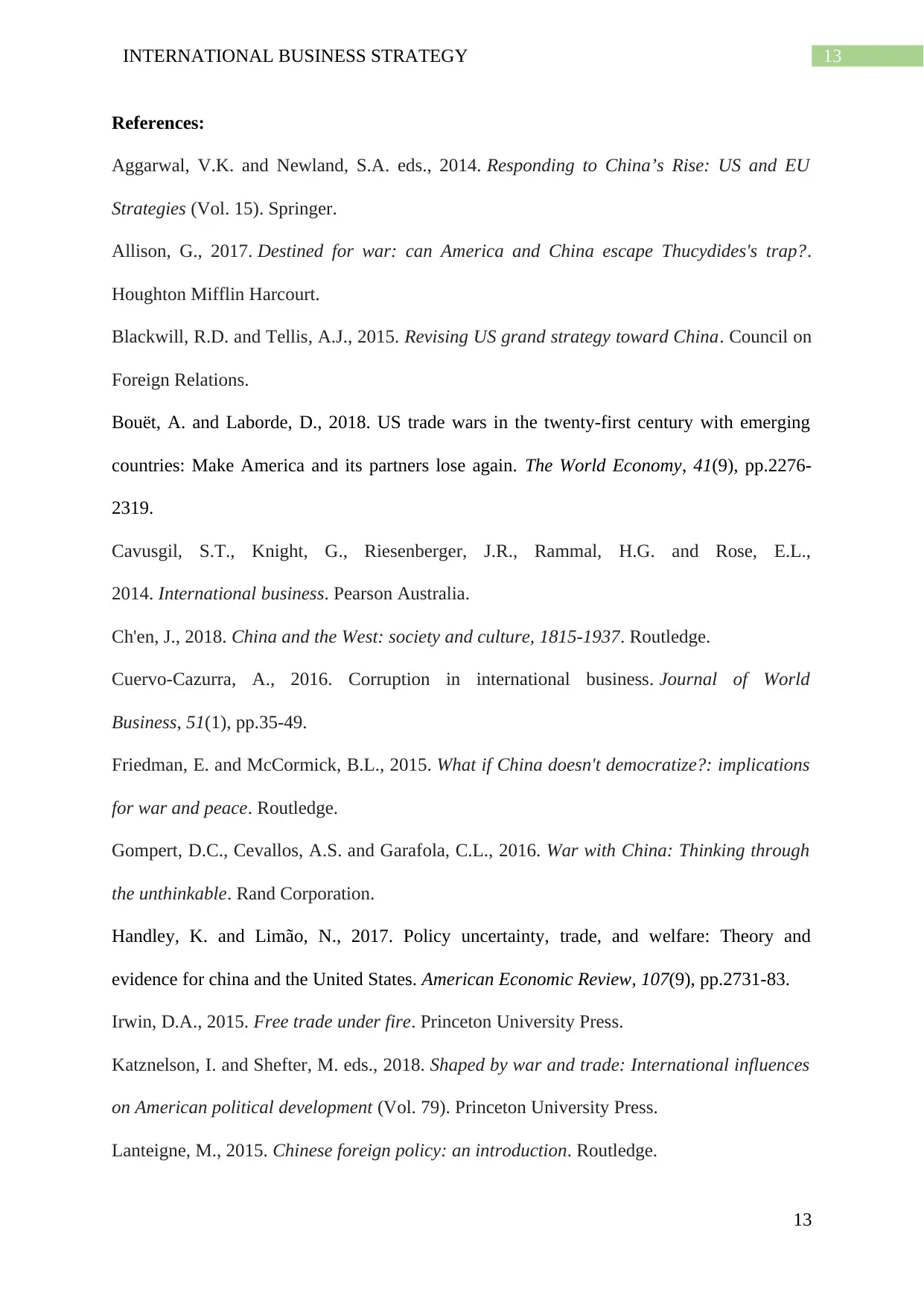
13INTERNATIONAL BUSINESS STRATEGY
References:
Aggarwal, V.K. and Newland, S.A. eds., 2014. Responding to China’s Rise: US and EU
Strategies (Vol. 15). Springer.
Allison, G., 2017. Destined for war: can America and China escape Thucydides's trap?.
Houghton Mifflin Harcourt.
Blackwill, R.D. and Tellis, A.J., 2015. Revising US grand strategy toward China. Council on
Foreign Relations.
Bouët, A. and Laborde, D., 2018. US trade wars in the twenty‐first century with emerging
countries: Make America and its partners lose again. The World Economy, 41(9), pp.2276-
2319.
Cavusgil, S.T., Knight, G., Riesenberger, J.R., Rammal, H.G. and Rose, E.L.,
2014. International business. Pearson Australia.
Ch'en, J., 2018. China and the West: society and culture, 1815-1937. Routledge.
Cuervo-Cazurra, A., 2016. Corruption in international business. Journal of World
Business, 51(1), pp.35-49.
Friedman, E. and McCormick, B.L., 2015. What if China doesn't democratize?: implications
for war and peace. Routledge.
Gompert, D.C., Cevallos, A.S. and Garafola, C.L., 2016. War with China: Thinking through
the unthinkable. Rand Corporation.
Handley, K. and Limão, N., 2017. Policy uncertainty, trade, and welfare: Theory and
evidence for china and the United States. American Economic Review, 107(9), pp.2731-83.
Irwin, D.A., 2015. Free trade under fire. Princeton University Press.
Katznelson, I. and Shefter, M. eds., 2018. Shaped by war and trade: International influences
on American political development (Vol. 79). Princeton University Press.
Lanteigne, M., 2015. Chinese foreign policy: an introduction. Routledge.
13
References:
Aggarwal, V.K. and Newland, S.A. eds., 2014. Responding to China’s Rise: US and EU
Strategies (Vol. 15). Springer.
Allison, G., 2017. Destined for war: can America and China escape Thucydides's trap?.
Houghton Mifflin Harcourt.
Blackwill, R.D. and Tellis, A.J., 2015. Revising US grand strategy toward China. Council on
Foreign Relations.
Bouët, A. and Laborde, D., 2018. US trade wars in the twenty‐first century with emerging
countries: Make America and its partners lose again. The World Economy, 41(9), pp.2276-
2319.
Cavusgil, S.T., Knight, G., Riesenberger, J.R., Rammal, H.G. and Rose, E.L.,
2014. International business. Pearson Australia.
Ch'en, J., 2018. China and the West: society and culture, 1815-1937. Routledge.
Cuervo-Cazurra, A., 2016. Corruption in international business. Journal of World
Business, 51(1), pp.35-49.
Friedman, E. and McCormick, B.L., 2015. What if China doesn't democratize?: implications
for war and peace. Routledge.
Gompert, D.C., Cevallos, A.S. and Garafola, C.L., 2016. War with China: Thinking through
the unthinkable. Rand Corporation.
Handley, K. and Limão, N., 2017. Policy uncertainty, trade, and welfare: Theory and
evidence for china and the United States. American Economic Review, 107(9), pp.2731-83.
Irwin, D.A., 2015. Free trade under fire. Princeton University Press.
Katznelson, I. and Shefter, M. eds., 2018. Shaped by war and trade: International influences
on American political development (Vol. 79). Princeton University Press.
Lanteigne, M., 2015. Chinese foreign policy: an introduction. Routledge.
13
Paraphrase This Document
Need a fresh take? Get an instant paraphrase of this document with our AI Paraphraser
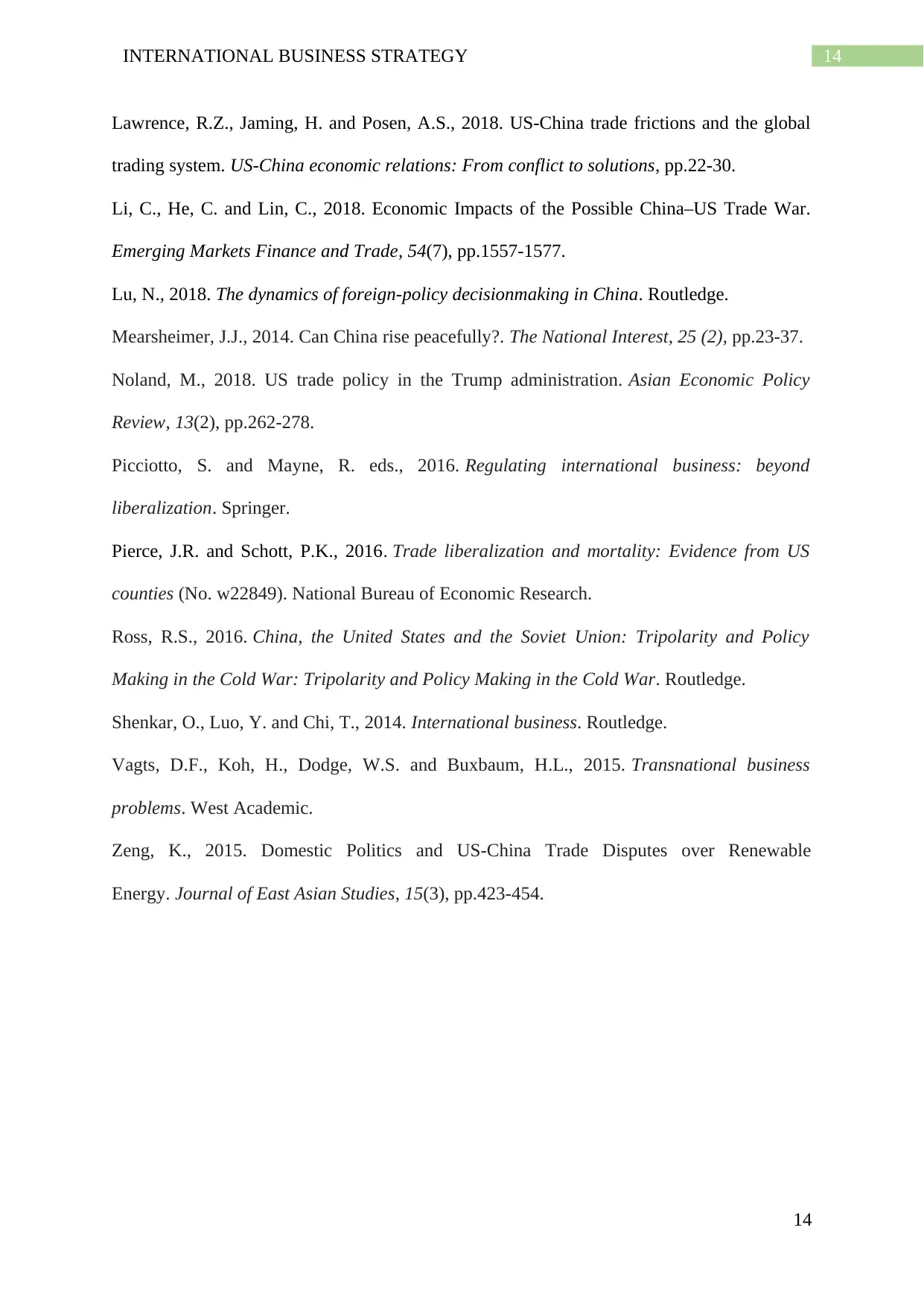
14INTERNATIONAL BUSINESS STRATEGY
Lawrence, R.Z., Jaming, H. and Posen, A.S., 2018. US-China trade frictions and the global
trading system. US-China economic relations: From conflict to solutions, pp.22-30.
Li, C., He, C. and Lin, C., 2018. Economic Impacts of the Possible China–US Trade War.
Emerging Markets Finance and Trade, 54(7), pp.1557-1577.
Lu, N., 2018. The dynamics of foreign-policy decisionmaking in China. Routledge.
Mearsheimer, J.J., 2014. Can China rise peacefully?. The National Interest, 25 (2), pp.23-37.
Noland, M., 2018. US trade policy in the Trump administration. Asian Economic Policy
Review, 13(2), pp.262-278.
Picciotto, S. and Mayne, R. eds., 2016. Regulating international business: beyond
liberalization. Springer.
Pierce, J.R. and Schott, P.K., 2016. Trade liberalization and mortality: Evidence from US
counties (No. w22849). National Bureau of Economic Research.
Ross, R.S., 2016. China, the United States and the Soviet Union: Tripolarity and Policy
Making in the Cold War: Tripolarity and Policy Making in the Cold War. Routledge.
Shenkar, O., Luo, Y. and Chi, T., 2014. International business. Routledge.
Vagts, D.F., Koh, H., Dodge, W.S. and Buxbaum, H.L., 2015. Transnational business
problems. West Academic.
Zeng, K., 2015. Domestic Politics and US-China Trade Disputes over Renewable
Energy. Journal of East Asian Studies, 15(3), pp.423-454.
14
Lawrence, R.Z., Jaming, H. and Posen, A.S., 2018. US-China trade frictions and the global
trading system. US-China economic relations: From conflict to solutions, pp.22-30.
Li, C., He, C. and Lin, C., 2018. Economic Impacts of the Possible China–US Trade War.
Emerging Markets Finance and Trade, 54(7), pp.1557-1577.
Lu, N., 2018. The dynamics of foreign-policy decisionmaking in China. Routledge.
Mearsheimer, J.J., 2014. Can China rise peacefully?. The National Interest, 25 (2), pp.23-37.
Noland, M., 2018. US trade policy in the Trump administration. Asian Economic Policy
Review, 13(2), pp.262-278.
Picciotto, S. and Mayne, R. eds., 2016. Regulating international business: beyond
liberalization. Springer.
Pierce, J.R. and Schott, P.K., 2016. Trade liberalization and mortality: Evidence from US
counties (No. w22849). National Bureau of Economic Research.
Ross, R.S., 2016. China, the United States and the Soviet Union: Tripolarity and Policy
Making in the Cold War: Tripolarity and Policy Making in the Cold War. Routledge.
Shenkar, O., Luo, Y. and Chi, T., 2014. International business. Routledge.
Vagts, D.F., Koh, H., Dodge, W.S. and Buxbaum, H.L., 2015. Transnational business
problems. West Academic.
Zeng, K., 2015. Domestic Politics and US-China Trade Disputes over Renewable
Energy. Journal of East Asian Studies, 15(3), pp.423-454.
14
1 out of 14
Related Documents
Your All-in-One AI-Powered Toolkit for Academic Success.
+13062052269
info@desklib.com
Available 24*7 on WhatsApp / Email
![[object Object]](/_next/static/media/star-bottom.7253800d.svg)
Unlock your academic potential
© 2024 | Zucol Services PVT LTD | All rights reserved.





